The definition of Public Relations has dramatically changed over the past few years.
What is Public Relations?
“Public relations is a process and practice of individuals and brands building relationships with journalists, bloggers and podcasts and spreading their message/information to the public by getting press coverage”.
Essentially, what this means is if nobody knows you exist, you won’t have any customers!
Here’s how Public Relations Society of America (PRSA) defines PR:
“Public relations is a strategic communication process that builds mutually beneficial relationships between organizations and their publics”.
Over the last few decades, the rise of new technologies, social media and new blogs, publications and influencers have reshaped the PR landscape.
Consequently, the public relations definition has also changed.
In this post, I will explain those changes, and how you must adapt to gain exposure for your business in this new PR landscape.
Here’s How it Used to Work
This is how a poor pitch email looks like:

In the dinosaur age (well, 20-30 years ago!), every company who wanted publicity and to manage their public image had to hire expensive public relations professionals.
That’s because access to the gatekeepers in traditional media was gained through years of relationship building. Through face-to-face communication, attending the same events and calling each other regularly.
Before, traditional media was one of the only ways to connect with the external publics – print news, television, radio. Remember those?
Another way to connect to the masses was advertising, through TV or print advertisements, which was hugely expensive and not a focused marketing strategy, even if you had the world’s largest PR budget.
Here’s What Changed
Then something was invented. The Internet. And it has completely upended the PR equation for all the parties involved.
Now that information has moved online, many different people and platforms command large audiences you can put your company in front of to mold public opinion. Everything from online publications, blogs, podcasts, social media, Youtube channels and so on.
Here’s another example of a poor email pitch:
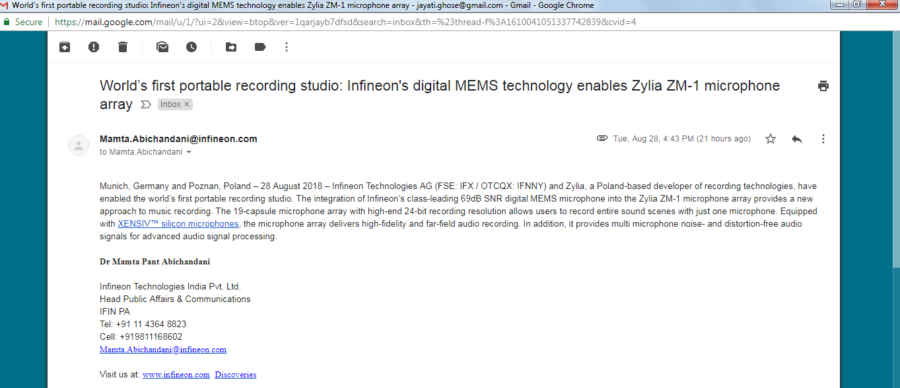
Let’s take a blogger for example. You don’t need to hire a high profile public relations agency who has excellent industry connections to cultivate a relationship with them. You don’t even have to pay large amounts to place an advertisement. In fact, this popular blogger may have only exploded a few months ago! Now you can directly email them to work out a promotion deal.
You certainly don’t need face-to-face communication to build relationships with influencers today. Email is only one of the many new ways you can do PR for yourself, at a fraction of the price.
Keep reading to learn 10+ new approaches you can act on right now to explode your website visitor count and user base.
Public relations definition change #1: Now you can do it yourself
Old public relations way
Previously, you had to hire public relations specialists to help with your public affairs because they were the only ones who had the connections and access to break into traditional media.
The best PR specialists would have strong relations in the industry, would be well-connected in PRSA and so on.
Also, expertise was locked up inside the brain of these public relations managers. You couldn’t really Google “how to do PR for your company” to pull up 10+ in-depth guides and DIY your way into landing press features.
There was no choice but to take the help of public relations professionals to reach your target journalist, your audience, and the external public.
New public relations way
With social media and Google research, you can find the names of most of the relevant gatekeepers and journalists you want to pitch on your own.
New tools like Clearbit Connect and Interseller help you uncover their email address to directly pitch to them and build relationships. In fact, according to a survey by Fractl conducted in 2014, the majority of journalists now prefer to be pitched by email:

“PR is simply a way for any brand to reach out to a relevant journalist and offer value up front without asking for anything in return.”
How to find relevant journalists to pitch yourself
1. Go to Google and toggle to News
Enter either a general phrase that describes what your company does or enter the name of a similar company
General phrase examples:
Peer to peer delivery
Photo sharing
Here are some news results you get when searching for photo sharing:
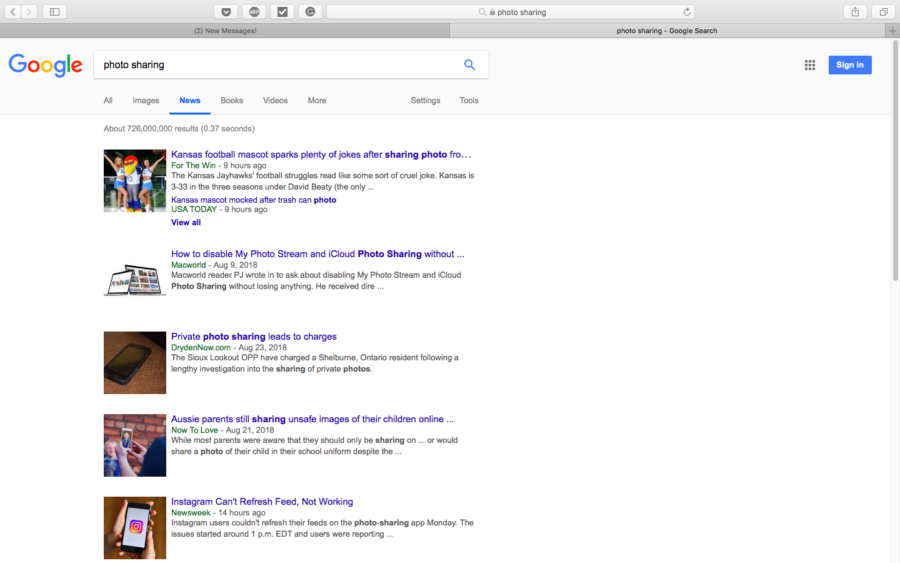
2. Visit each article to get the author details
If the author is a staff writer, add their full name and publication to a spreadsheet.
If the author is a contributor (which means they likely don’t have an email address with that publication), go to their social media to find out what is their company or personal site is. Then add their full name and that website to the spreadsheet.

Tools like Clearbit Connect can help you find email addresses’ of key writers and journalists within a media organization. Use Clearbit chrome extension to enter the name of the journalist and the tool will display everything about your prospect including location, job title, social profiles, and email address.

You can also use Interseller’s LinkedIn chrome extension to find email addresses of specific journalists listed on your spreadsheet.
Once you download Interseller LinkedIn chrome extension, go to your LinkedIn account and search for the journalist you want to contact. When you reach the journalists’ LinkedIn page, click on the chrome extension and the tool will show you an associated email.

Interseller gives you verified email addresses which have already been validated, so you don’t have to worry about your emails bouncing or not reaching the right contact.
You can use any of these 20 journalist outreach tools to maximize your results.
4. Pitching your company by feeding the journalist a story angle about it
Don’t just pitch the journalist what your company does. Feed them a story idea about it so they can quickly see its potential to serve their primary goal of educating and entertaining their audience.
For example, in this New Yorker article about Soylent, the author doesn’t focus primarily on what it is (a meal replacement):
It starts off describing what inspired the founders to create Soylent in the first place:
Down to their last seventy thousand dollars, they resolved to keep trying out new software ideas until they ran out of money. But how to make the funds last? Rent was a sunk cost. Since they were working frantically, they already had no social life. As they examined their budget, one big problem remained: food.
5. Brainstorming story angles to pitch for your company
What you do: peer to peer delivery
Story angles:
An angle relevant to the publication’s focus: Now you can enjoy all your favorite restaurants on your own couch or even in bed. Including the ones that don’t deliver themselves or via another service.
What inspired you to make it: Before, I was a lawyer in LA. Given the constant gridlock, it was hard to run my errands scattered all across town.. So I created a platform to connect with people who were already planning to go there and could do it for me. They earn extra money. I save tons of time.
Public relations definition change #2: News moved online, which means you can earn exposure and traffic beyond a press feature
Old public relations way
Back in the day, most people got their news from a few sources like radio, television and the newspaper. Unless you or your company did something newsworthy (and it may not always be good news!), it is hard to break into these outlets without someone, especially PR specialists, knowing about relevant opportunities as they come up and referring you to it. You had to depend on the public relations society to get you featured in the press.
New public relations way
Now that news has moved online and sources of information has expanded from traditional media to many different types of players from social media influencers to bloggers, you can gain traffic and exposure from them as well. Often with lower bars to entry. In fact, getting featured in a relevant high traffic non-news site can drive as many new visitors to your site as a feature in the press.
Here’s a screenshot of the traffic Seth from Subimage LLC received when he was interviewed 6 times in 9 days. It peaked at 300 sessions in one day:
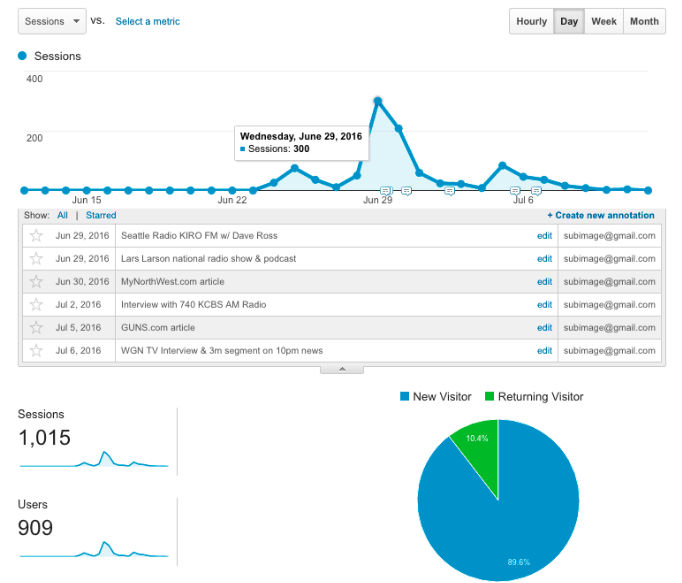
Here’s the traffic Subimage LLC received when he was featured on the front page of Hacker News, a community tech site. It peaked at a whopping 18 948 sessions:
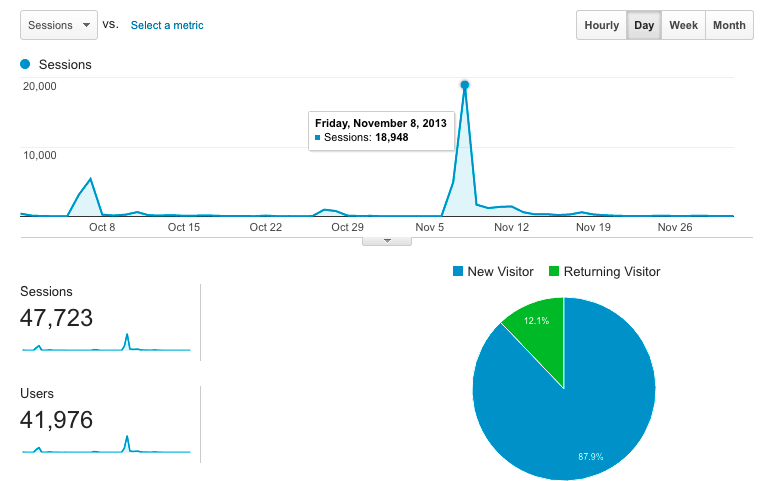
This goes to show that relevant community sites can beat out traditional media in driving a flood of relevant visitors to your site.
And the thing is all these media mentions of you brand drive your SEO rankings significantly. Here is how Adam the founder of Loganix puts it:
Public relations is now critical for SEO. Acquiring positive brand mentions boosts your link profile and accelerates both traffic and authority.
How to post your company on a high traffic community site
Search for ‘[your industry] forum” and the top results tend to be the most popular community sites around that topic.
For example, here are some results you get for when you search for ‘car forum’:

1. Start by leaving meaningful comments
This shows the community you’re there to provide value, not only to promote yourself. Communication is essential to build a strong reputation as a value provider.
2. Getting around guidelines around self-promotion
Many community sites don’t really allow blatant self-promotion but you can get around it by requesting feedback on your company instead. Or by offering an interesting or educational experience related to it.
For example, here’s how a poster on Reddit gained exposure to his business case studies site by asking for feedback on it on a relevant sub-forum (one for entrepreneurs):

Be sure to check back the thread regularly to provide meaningful answers to any questions other members may ask. This encourages a two-way communication and has the added benefit of keeping the thread closer to the top of the page so more members can see it.
3. Some journalists browse community sites for scoops so it may land you a feature
A lot of journalists these days actively browse community sites for story ideas and scoops, especially ones centered around their local city. These sites could be a great potential for marketing your product or company.
Here’s an example of a Toronto Star journalist who browsed community sites and Twitter to cite in her article:

Public relations definition change #3: Now algorithms and technology can help you find the right people to connect with and track the impact
Old public relations way
Before, when information lived offline, you needed the help of public relations practitioners who knew where press opportunities existed to refer you to them. They had to develop detailed public relations strategies to ensure strong media relations. They had earned the reputation as gatekeepers for all public relations programs.
New public relations way
Finding relevant opportunities
After all the information moved online, you can find the right people to contact yourself with Google research and online tools.
1. Finding relevant journalists to pitch
In JustReachOut, you can find all the recent stories that was written about a similar company and the contact information of authors so you can pitch them yourself.
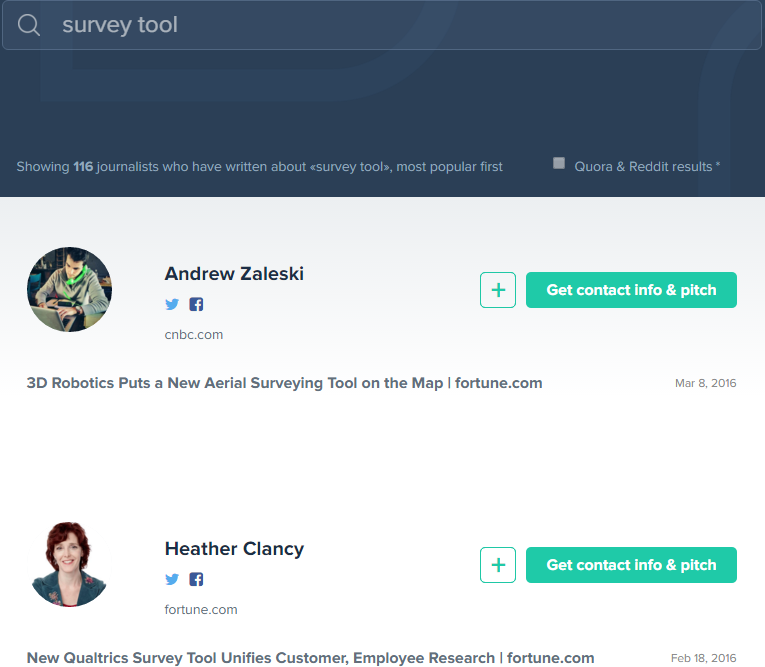
A lot of times you can find the journalist’s personal website and subscribe to their newsletter in order to find their email address. Another quick tip is to engage with the chatbot on the site (if it has one) and ask it for a general contact email address. You can then write the pitch to the general contact email address and ask for the right person to speak to regarding your news pitch.
2. Connecting with journalists who are looking for a source for their article
On HARO, journalists submit requests seeking expert experiences and insights for articles they are working on right now.
When you subscribe to it, they send you a few emails a day with a roundup of these requests (you can subscribe and unsubscribe to certain topics).
Before the advent of email and websites, it was difficult for journalists to go beyond their own contact list and referrals to find sources. They had to depend on public relations firms to send them relevant information on companies with which journalists did not have direct communication. Now you can receive requests from dozens of journalists every day in your inbox!
Responding to their requests and explaining how you can contribute relevant experience and expertise gives you a much better chance of getting featured since these journalists are actively looking for someone to feature. This also builds mutually beneficial relationships. When responding to these questions from journalists make sure to speak their language, according to Harvard Business Review 71% of professionals say that language and tone is the main factor behind ‘unproductive’ and ‘inefficient’ communication.
Here’s an example of how a query inside a HARO email looks like:
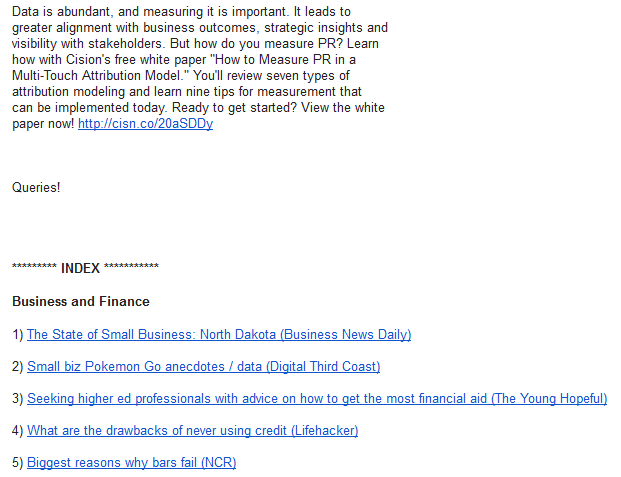
You can also sign up to receive Google notifications whenever your competitors are mentioned in the press so you can reach out and build relationships with those journalists as well:

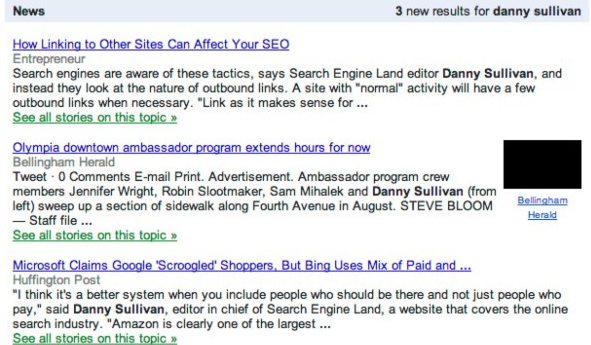
3. Provide data and insights to journalists
Journalists love supplementary materials that make it more interesting to read their article. Since they work under tight deadlines, they may not always have the time to find or create it themselves so they are often receptive to ones that are offered to them. You can use this strategy to develop a problem-solving process for the journalist which can be mutually beneficial.
For example, I pitched journalists offering an interactive poll for their articles and earned the company I worked for at that time, Polar, many links.

Using your own proprietary data points to provide trends and statistics that a journalists might find useful for their articles. For instance, an online toy store can dig through their sales data to identify the most popular gifts for this year’s Christmas season. Journalists love to augment their news items with such stats. Also, being the source for such stats help you establish your business as the authority in your industry.
Being able to access any information with the push of a few buttons and in some cases, being able to have relevant information delivered straight to you, means you no longer need a public relations department to monitor all the publications out there for press opportunities or to push your press releases.
Measuring the results of publicity
Before, when publicity happened mostly on traditional media, one of the few metrics you could track was how many more sales you made after a press feature. This is imprecise because you cannot know for sure whether a press mention lead to the sale or whether it would have happened anyway.
Now that information has moved online, it can be discovered and consumed on many new channels from Google search results to social media, your public relations campaign results can be tracked on a much more accurate and granular level.
For example, if an influential site with a strong reputation in your industry links to your company, you can track metrics including:
- How many new visitors you received from this link
- At what rate they performed events important to you (examples: subscribed to your email list, signed up for a trial, purchase an item)
These new metrics give you much greater insight into what PR strategies are delivering you high-value visitors and which are not so you can continually tweak and improve your public relations activities and device better strategic communication.
Tracking the journeys visitors from different sources take on your website
- Go to Google Analytics -> Behavior -> Behavior Flow

- Toggle your traffic view to Source
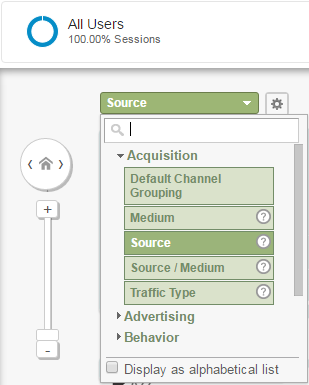
- Find your referral of interest to see how visitors from there navigate through your site
Find your referral of interest such as nytimes.com or reddit.com and click on ‘Highlight traffic through there’:

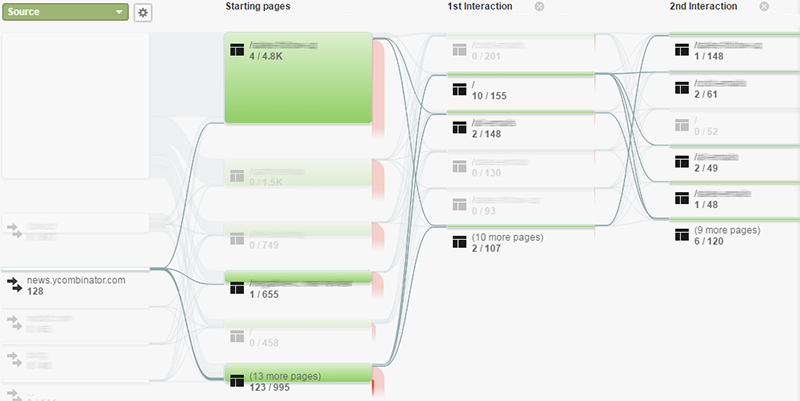
Bottom line: the definitions of public relations has changed radically.
You and your new powers to create effective public relations are now part of the equation!
With the rise of new ways, tools and approaches to research and find PR opportunities, it means you no longer have to hire a PR agency or PR professionals who spent years gaining access to the traditional outlets and gatekeepers.
Now you can either do it yourself, focusing on the highest payoff approaches. Or each member of your team can incorporate PR goals into their work. From your SEO wizard to your social media manager. You also don’t have to make huge payouts for advertising or marketing through traditional channels.
Public relations is no a longer a:
One way relationship where you and your PR team build and gain access to relationships and opportunities to help your target audience discover your company.
Instead, public relations PR can be redefined as a continual feedback loop:
- You generate PR
- An audience, discovering or consuming it real-time on social media, online news and other sources quickly consumes it and/or reacts to it
- You tweak your strategy and messaging in response
- They consume and react again
- The loop continues.






Very interesting post. Gained lots of insights for my startup PR. Thanks!
Informative post! Thanks for the info. I also use remail.io and can’t recommend it more highly. Remail helps me reach more people by automating email prospecting in a way that’s still as personal as it can be.
This is the best comprehensive blog post on DIY PR. Thank you very much. I have bookmarked the page for a regular visit.
Great post! I always thought telling a journalist what my company does is sufficient and they will be the best judge of how that fact is relevant to their readers. But I understand that pitching them a relevant story angle instead is the better idea.
Thank you Dmitry! Your post has given me the confidence to go ahead and do my own PR. I no longer have to get into lengthy debates with expensive public relations agencies and can focus on strategies with the highest payoffs.
Hi Dmitry, this was very informative. Do you have posts that I can refer on how to do PR outreach? I want to understand what journalists want in a media pitch. Thanks! Nash